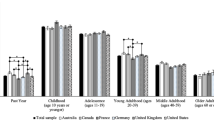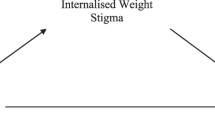Abstract
Objective:
To compare the strength of weight bias to other common biases, and to develop a psychometrically sound measure to assess and compare bias against different targets.
Subjects:
A total of 368 university students (75.4% women, 47.6% white, mean age: 21.53 years, mean body mass index (BMI): 23.01 kg/m2).
Measurements:
A measure was developed to assess bias against different targets. Three versions of the universal measure of bias (UMB) were developed and validated, each focusing on either ‘fat,’ ‘gay’ or ‘Muslim’ individuals. These were administered to participants, along with two established scales of bias against each target and a measure of socially desirable response style.
Results:
The UMB demonstrated good internal consistency, appropriate item-total and inter-item correlations, and a clear factor structure suggesting components of Negative Judgment, Distance, Attraction and Equal Rights. Construct validity was indicated by strong correlations between established measures of bias and each corresponding version of the new scale. In contrast to previously established measures of weight bias, the new measure was independent of socially desirable response style. Although homosexual orientation was associated with lower gay bias (P<0.05), greater BMI was not associated with any decrease in weight bias. When comparing the relative strength of bias against different targets, weight bias was significantly greater than bias against both gays and Muslims (P<0.001).
Conclusion:
Weight bias is significantly stronger than other major targets of bias. This is the first study to develop a universal measure to assess bias against different targets. The excellent psychometric properties of this measure will permit further investigation into the relative severity of different types of prejudice over time and across samples. The present findings suggest that the pervasive discrimination against obese individuals may be more socially acceptable than discrimination against other groups.
This is a preview of subscription content, access via your institution
Access options
Subscribe to this journal
Receive 12 print issues and online access
$259.00 per year
only $21.58 per issue
Buy this article
- Purchase on Springer Link
- Instant access to full article PDF
Prices may be subject to local taxes which are calculated during checkout
Similar content being viewed by others
References
Puhl RM, Brownell KD . Bias, discrimination, and obesity. Obes Res 2001; 9: 788–805.
Brownell KD, Puhl RM, Schwartz MB, Rudd L (eds) Weight Bias: Nature, Consequences, and Remedies. Guilford: New York, 2005.
Puhl RM, Latner JD . Stigma, obesity, and the health of the nation's children. Psychol Bul 2007; 133: 557–580.
Latner JD, Stunkard AJ . Getting worse: the stigmatization of obese children. Obes Res 2003; 11: 452–456.
McConahay JB . Modern racism, ambivalence, and the modern racism scale.In: Dovidio JF, Gaertner SL (eds). Prejudice, Discrimination, and Racism. Academic Press: Orlando, FL, 1986,pp 91–125.
Crandall CS . Prejudice against fat people: ideology and self-interest. J Pers Soc Psychol 1994; 66: 882–894.
Puhl RM, Schwartz MB, Brownell KD . Impact of perceived consensus on stereotypes about obese people: new avenues for bias reduction. Health Psychol 2005; 24: 517–525.
DeJong W . Obesity as a characterological stigma: the issue of responsibility and judgments of task performance. Psychol Rep 1993; 73: 963–970.
Sigelman CK . The effect of causal information on peer perceptions of children with physical problems. J Appl Dev Psychol 1991; 12: 237–253.
Richardson SA, Goodman N, Hastorf AH, Dornbusch SM . Cultural uniformity in reaction to physical disabilities. Am Sociol Rev 1961; 26: 241–247.
Goodman N, Dornbusch SM, Richardson SA, Hastorf AH . Variant reactions of physical disabilities. Am Sociol Rev 1963; 28: 429–435.
Maddox GL, Back KW, Liederman VR . Overweight as social deviance and disability. J Health Soc Behav 1968; 9: 287–298.
Latner JD, Simmonds MB, Rosewall J, Stunkard AJ . Assessment of obesity stigmatization in children and adolescents: modernizing a standard measure. Obes 2007; 15: 3078–3085.
Lewis RJ, Cash TF, Jacobi L, Bubb-Lewis C . Prejudice toward fat people: the development and validation of the antifat attitudes test. Obes Res 1997; 5: 297–307.
Herek GM . Heterosexuals’ attitudes toward lesbians and gay men: correlates and gender differences. J Sex Res 1988; 25: 451–477.
Reynolds WM . Development of reliable and valid short forms of the Marlowe–Crowne Social Desirability scale. J Clin Psychol 1982; 38: 119–125.
Allison DB, Basile VC, Yuker HE . The measurement of attitudes toward and beliefs about obese persons. Int J Eat Disord 1991; 10: 599–607.
Wright LW, Adams HE, Bernat J . Development and validation of the Homophobia Scale. J Psychopathol Behav Assess 1999; 21: 337–347.
Worthington RL, Dillon FR, Becker-Schutte AM . Development, reliability, and validity of the Lesbian, Gay, and Bisexual Knowledge and Attitudes Scale for Heterosexuals (LGB-KASH). J Couns Psychol 2005; 52: 104–118.
Altareb BY . Attitudes Towards Muslims: Initial Scale Development. Doctoral Dissertation, Ball State University: Muncie, IL, 1997.
Pettigrew TF, Meertens RW . Subtle and blatant prejudice in Western Europe. Eur J Soc Psychol 1995; 25: 57–75.
Coryn CL, Beale JM, Myers KM . Response to September 11: anxiety, patriotism, and prejudice in the aftermath of terror. Curr Res Soc Psychol 2004; 9: 165–184.
Crowne DP, Marlowe D . A new scale of social desirability independent of psychopathology. J Consult Psychol 1960; 4: 349–354.
Clark LA, Watson D . Constructing validity: basic issues in objective scale development. Psychol Assess 1995; 7: 309–319.
Haynes SN, Richard DCS, Kubany ES . Content validity in psychological assessment: a functional approach to concepts and methods. Psychol Assess 1995; 7: 238–247.
Kingree JB, Daves WF . Preliminary validation of the attitudes toward homelessness inventory. J Comm Psychol 1997; 25: 265–288.
Lester HE, Pattison HM . Development and validation of the Attitudes Towards the Homeless questionnaire. Med Ed 2000; 34: 266–268.
Crandall CS . Do heavy-weight students have more difficulty paying for college? Pers Soc Psychol Bull 1991; 17: 606–611.
Crosnoe R . Gender, obesity, and education. Sociol Ed 2007; 80: 241–260.
Canning H, Mayer J . Obesity—its possible effect on college acceptance. N Engl J Med 1966; 275: 1172–1174.
Gortmaker SL, Must A, Perrin JM, Sobol AM, Dietz WH . Social and economic consequences of overweight in adolescence and young adulthood. N Engl J Med 1993; 329: 1008–1012.
Sargent JD, Blanchflower DG . Obesity and stature in adolescence and earnings in young adulthood. Arch Pediatr Adolesc Med 1994; 148: 681–687.
Smith GT, McCarthy DM . Methodological considerations in the refinement of clinical assessment instruments. Psychol Assess 1995; 7: 300–308.
Latner JD, Stunkard AJ, Wilson GT . Stigmatized students: age, sex, and ethnicity effects in the stigmatization of obesity. Obes Res 2005; 13: 1226–1231.
Firebaugh G, Davis KE . Trends in antiblack prejudice, 1972–1984: region and cohort effects. Am J Sociol 1988; 94: 251–272.
Herek H . The psychology of sexual prejudice. Cur Dir Psychol Sci 2000; 9: 19–22.
Hebl MR, Foster JB, Mannix LM, Dovidio JF . Formal and interpersonal discrimination: a field study of bias toward homosexual applicants. Pers Soc Psychol Bull 2002; 28: 815–825.
Wang SS, Brownell KD, Wadden TA . The influence of the stigma of obesity on overweight individuals. Int J Obes 2004; 28: 1333–1337.
Sarlio-Lähteenkorva S, Silventoinen K, Lahelma E . Relative weight and income at different levels of socioeconomic status. Am J Public Health 2004; 94: 468–472.
French SA, Jeffery RW, Folsom AR, McGovern P, Williamson DF . Weight loss maintenance in young adulthood: prevalence and correlations with health behavior and disease in a population based sample of women aged 55–69 years. Int J Obes 1996; 20: 303–310.
Durso LE, Latner JD . Understanding self-directed stigma: development of the Weight Bias Internalization scale. Obesity,(in press).
Bessenoff GR, Sherman JW . Automatic and controlled components of prejudice toward fat people: evaluation versus stereotype activation. Soc Cognition 2000; 18: 329–353.
O’Brien KS, Latner JD, Halberstadt J, Hunter JA, Anderson J, Caputi P . Do anti-fat attitudes predict anti-fat behaviours? Obesity, (in press).
Author information
Authors and Affiliations
Corresponding author
Rights and permissions
About this article
Cite this article
Latner, J., O'Brien, K., Durso, L. et al. Weighing obesity stigma: the relative strength of different forms of bias. Int J Obes 32, 1145–1152 (2008). https://doi.org/10.1038/ijo.2008.53
Received:
Revised:
Accepted:
Published:
Issue Date:
DOI: https://doi.org/10.1038/ijo.2008.53
Keywords
This article is cited by
-
The perceptions of healthcare practitioners on obesity management in Peninsular Malaysia: a cross-sectional survey
BMC Health Services Research (2023)
-
Can Brief Video Trainings Reduce Bias and Improve Knowledge and Attitudes Toward Applicants with Disabilities?
Journal of Business and Psychology (2023)
-
The Persistence of Prejudice: Voters Strongly Penalize Candidates with HIV
Political Behavior (2022)
-
Leading When Overweight: the Influence of Supervisor Body Weight on Subordinates’ Perceptions and Citizenship Behaviors
Journal of Business and Psychology (2022)
-
Weight Stigma, Chronic Stress, Unhealthy Diet, and Obesity in Chilean Adults
International Journal of Behavioral Medicine (2021)



